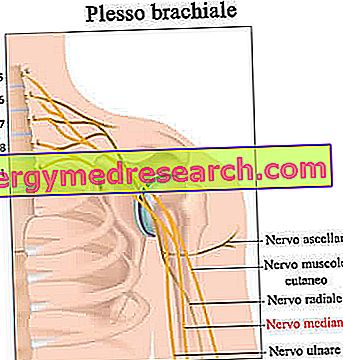Generality
The brachial plexus is the reticular complex of spinal nerves that provides motor and sensory innervation of a part of the thorax, shoulder, arm and hand.
To be precise, to compose the so-called brachial plexus are the anterior branches of the last 4 cervical spinal nerves (C5, C6, C7 and C8) and of the first thoracic spinal nerve (T1).

The brachial plexus can be the victim of traumatic injuries and tumors.
Traumatic injuries - which represent the most common problems affecting the brachial plexus - are generally the consequence of motorcycle accidents, severe clashes during sporting activities or a birth in which the unborn child weighs heavily and is large (NB : in such circumstances, it is opportune to specify it, the child is the victim of the accident).
Short review of what a nerve is
To fully understand what a nerve is, it is necessary to start from the concept of neuron .
Neurons represent the functional unit of the nervous system . Their task is to generate, exchange and transmit all those (nervous) signals that allow muscle movement, sensory perceptions, reflex responses and so on.
Typically, one neuron consists of three parts:
- The so-called body, where the cell nucleus resides.
- Dendrites, which are equivalent to receiving antennae for nerve signals from other neurons or receptors located in the periphery.
- Axons, which are cellular extensions having the function of spreading the nervous signal. The axon covered with myelin (myelin sheath) is also called nerve fiber.

Nerves can carry information in three ways:
- From the central nervous system (CNS) to the periphery . The nerves with this property are called efferent. The efferent nerves control the movement of the muscles, so I am in charge of the motor sphere.
- From the periphery to the CNS . Nerves with this capacity are called afferent. The afferent nerves signal to the CNS what they detected in the periphery, therefore they cover a sensitive (or sensory) function.
- From the SNC to the periphery and vice versa . Nerves with this double capacity are called mixed. Mixed nerves have a dual function: motor and sensory.
What is the brachial plexus?
The brachial plexus is an important reticular complex of spinal nerves of the human body, to which the anterior branches of the last 4 cervical spinal nerves (C5, C6, C7 and C8) and of the first thoracic spinal nerve ( T1).
Spinal nerves are nerve structures belonging to the so-called peripheral nervous system (so they are peripheral nerves ). The peripheral nervous system (or PNS ) is the "arm" of the central nervous system (or CNS ). In fact, his job consists in transmitting to the CNS all the informative data captured inside and outside the organism and in spreading all processing with origin in the CNS towards the periphery. Without the SNP, the central nervous system could not function properly.
NB: to learn more about "spinal nerves", readers are advised to read the article here.
Anatomy
The brachial plexus begins at the level of the spinal cord - where the anterior branches of the 5 aforementioned spinal nerves are born - passes through the cervico-axillary canal present in the neck, passes over the first rib and is introduced into the axilla (or axillary cavity).
STRUCTURE OF THE BRACHIAL PLEXUS
According to the anatomists, the brachial plexus can be divided into 5 sections . Starting from the spinal cord (considered the point of origin of the brachial plexus), these sections are: the section of the 5 roots, the section of the 3 trunks, the section of the 6 divisions, the section of the 3 strings and the section of the 5 branches terminals .
- Roots. The 5 roots of the brachial plexus are the 5 anterior branches of the 5 spinal nerves mentioned at the beginning of the article, namely the spinal nerves C5, C6, C7, C8 and T1 .
For the avoidance of doubt, the roots are indicated with the same alphanumeric characters of the spinal nerves.
- Logs. Identified with the terms of upper trunk, middle trunk and lower trunk, the 3 trunks of the brachial plexus derive from the aforementioned 5 roots. To be precise, the upper trunk is derived from the spinal nerve roots C5 and C6; the middle trunk derives from the root of the spinal nerve C7; finally, the lower trunk derives from the roots of the spinal nerves C8 and T1.
- Divisions. The 6 divisions derive, in pairs, from the 3 trunks. In fact, at some point in his journey, each trunk divides into two, giving rise to an anterior division and a posterior division . Therefore, of the 6 divisions constituting the brachial plexus, 3 are called anterior (anterior division of the upper trunk, anterior division of the middle trunk and so on) and 3 are called posterior (posterior division of the upper trunk and so on).
- Ropes. Identified with the terms of posterior chord, side chord and medial chord, the 3 chords are a grouping of several divisions. To be more precise, the posterior chord groups all three of the posterior divisions, therefore it includes the nerve bundles belonging to the roots C5, C6, C7, C8 and T1; the lateral chord groups the anterior divisions of the upper and middle trunks, therefore it includes the nerve bundles belonging to the roots C5, C6 and C7; finally, the medial chord is a continuation of the anterior division of the lower trunk, therefore it includes the nerve bundles belonging to the C8 and T1 roots.
- Terminal branches. Originating from the 3 strings, the 5 branches of the brachial plexus are real nerves, called: musculocutaneous nerve, ulnar nerve, median nerve, radial nerve and axillary nerve .

The ulnar nerve is derived from the medial chord and groups the C8 and T1 roots.
The median nerve derives, in part, from the medial chord (includes the C5, C6 and C7 roots) and, in part, from the lateral chord (includes the C8 and T1 roots).
The radial nerve continues the posterior chord and groups the roots C5, C6, C7, C8 and T1.
Finally, the axillary nerve is in continuity with a part of the posterior chord, to be precise that comprising the roots C5 and C6.

Motor and sensory functions of the terminal branches | ||
Terminal branch of the brachial plexus | Motor functions | Sensitive functions |
Musculocutaneous nerve | It innervates the coracobrachial muscle, the brachialis muscle and the biceps brachialis muscle (NB: these are some of the muscles of the arm) | It preserves a cutaneous portion of the forearm |
Ulnar nerve | Innervates the flexor carpi ulnar muscle, part of the deep flexor muscles of the fingers of the hand, the extrinsic muscles of the hand (except the tenar muscles and the two lateral lumbricals). | Innervates the skin of the medial side of the hand, the palmar skin of the first 3 and a half fingers (thumb, index, middle and half ring) and the dorsal skin of the first two and a half fingers (thumb, index and middle middle). |
Median nerve | At the level of the forearm, it innervates the muscles directly: round pronator, radial flexor of the carpus, long palmar and superficial flexor of the fingers of the hand; on the other hand, it indirectly innervates (ie through branches) the muscles: long flexor of the thumb, square pronator and deep flexor of the fingers of the hand (only the radial half). At the level of the hand, it indirectly innervates the tenar muscles of the hand and the lateral lumbrical muscles of the hand. | The sensory functions of the median nerve belong only to its branches. Through the latter, therefore, it innervates the skin of the lateral portion of the palm of the hand, the palmar surface of the thumb, index, middle and part of the ring finger and the dorsal surface of the tip of the thumb, index and middle finger. |
Radial nerve | Innervates the triceps brachialis muscle, the supinator muscle, the anconeus muscle, the extensor muscle of the forearm and the brachioradialis muscle | Through its branches, it innervates: the skin of the posterior portion of the arm, the skin of the lateral portion of the arm, the skin of the posterior and central region of the forearm and, finally, the skin of the dorsal surface of the thumb, index, middle and middle annular. |
Axillary nerve | It preserves part of the deltoid muscle and the small round muscle. | Transmits sensitive information from the shoulder joint. |
PRETERMINAL OR COLLATERAL BRANCHE
In reality, the brachial plexus also has other nerve branches, which however anatomists tend to exclude from the description of the main structure, as they are "less important". These other nerve branches are called preterminal branches and collateral branches, since they originate in points of the brachial plexus preceding the ropes or from one of the terminal branches.
The list of collateral branches of the brachial plexus includes:
- The scapular dorsal nerve . It comes from the root C5. It provides innervation of the large rhomboid and small rhomboid muscles.
- The long thoracic nerve . It derives from the roots C5, C6 and C7. Innervates the anterior serratus muscle.
- The phrenic nerve . It originates from the C3, C4 and C5 roots (NB: C3 and C4 are not part of the brachial plexus). It provides for the innervation of the diaphragm.
- The subclavian nerve . It originates at a point in the upper trunk of the brachial plexus. Check out the subclavian nerve.
- The suprascapular nerve . It originates in a point of the upper trunk of the brachial plexus, therefore it includes the nerve bundles belonging to the cervical spinal nerves C5 and C6. It provides the innervation of the supraspinatus muscle and the infraspinated (or sub-spinal) muscle.
- The lateral pectoral nerve . It originates at a point on the lateral chord of the brachial plexus, therefore it includes the nerve bundles belonging to the cervical spinal nerves C5, C6 and C7. Innervates a portion of the pectoralis major muscle and the pectoralis minor muscle.
- The medial pectoral nerve . It originates in a point of the medial chord of the brachial plexus, therefore it includes the nerve bundles belonging to the cervical spinal nerve C8 and to the thoracic spinal nerve T1. Provides for the innervation of a part of the pectoralis major muscle and a part of the small pectoral muscle.
- The medial cutaneous nerve of the arm . It originates from the medial chord of the brachial plexus. Transmits sensitive information from the skin of the medial portion of the arm to the CNS.
- The medial cutaneous nerve of the forearm . It originates at a point on the medial chord of the brachial plexus. Transmits sensitive information from the skin of the medial portion of the forearm to the CNS.
Function
With its innumerable nerve branches, the brachial plexus provides motor and sensory innervation of a part of the thorax, shoulder, arm and hand.
WHAT WAS NOT INVERTER?
The brachial plexus does not innervate the trapezius muscle and neither does the skin area near the axilla. The innervation of the trapezius muscle is up to the accessory nerve (a cranial nerve), while the innervation of the skin area near the armpit is up to the intercostobrachial nerve .
Associated pathologies
The brachial plexus can be the victim of traumatic injuries or - although much more rarely - of tumors .
TRAUMATIC INJURIES
In most cases, traumatic injuries to the brachial plexus are the consequence of motorcycle accidents, of hard fights during sports activities, in which physical contact is expected, and finally, the consequence of parts, in which the unborn child weighs much and it is of large dimensions (NB: in such circumstances, it is opportune to specify it, the child is the victim of the accident).
An injury to the brachial plexus can have repercussions both under the motor profile and under the sensitive profile.
The symptomatic picture varies from case to case and depends on which portion of the brachial plexus has suffered the injury. For example, a brachial plexus injury, which involves injury to the medial chord, has different effects than a brachial plexus injury, which results in injury to the lateral cord.
From the diagnostic point of view, to understand which is the exact injured portion of the brachial plexus, the doctors compare the motor and sensory capacities of the injured upper limb with those of the healthy upper limb.
CANCER AT THE BRACHIAL PLEXUS
Schwannoma, neurofibroma and malignant tumor of peripheral nerve sheaths are the three types of cancer that can affect the brachial plexus.




